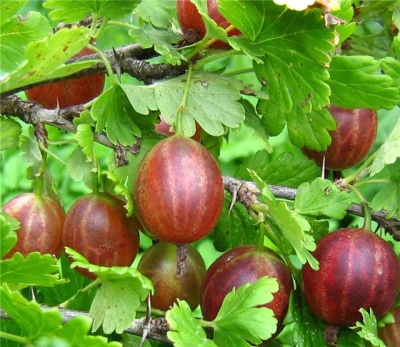
- Authors: M. N. Simonova, Moscow Fruit and Berry Experimental Station (VSSTISP)
- Appeared when crossing: Houghton x Bottled Green
- Year of approval: 1959
- Growth type: vigorous
- Description of the bush: medium spreading under crop load
- Escapes: non-lignified - of medium thickness, curved, not pubescent, light green, the apical part of the shoots with a weak anthocyanin color; lignified - of medium thickness, curved, long, gray in color with characteristic strokes along the entire length of the shoot
- Thorniness: medium
- Thorns: single, short, less than 7 mm, medium thickness, dark color, matte
- Sheet: three-lobed, large and medium, light green, with low sheen
- Spike location: along the entire length of the shoot, absent on the tops and on the fruiting branches
Gooseberry is a berry familiar from childhood. The Smena variety has been known to gardeners since 1959. Thanks to the painstaking work of domestic breeders, the plant can be grown in almost any corner of Russia. The culture does not require special care skills.
Description of the variety
Vigorous bushes reach a height of 180 cm. Medium spreading, with powerful stems. Young shoots are of medium thickness, hairless and slightly curved. Their color is light green, the top is dark pink. Lignified twigs of medium thickness, curved and long, gray in color.
Single, short spines located along the entire length of the shoots. They are absent on the tops and on the fruiting branches. Leaves are large and medium in size, three-lobed, smooth, slightly glossy. Their color is light green. The surface is pubescent on both sides.
Peduncles of medium size, buds of light green color, with a pink border, collected in inflorescences of 2-3 pieces. Damaged shoots recover well.
The variety has a number of advantages:
high productivity;
good winter hardiness and drought resistance;
berries do not crack;
self-fertility.
But there are also a number of disadvantages:
overgrowth formation leads to thickening;
small fruits;
often affected by diseases;
low resistance to spotting.
Characteristics of berries
The berries are small and medium, each weighing from 2.5 to 3.5 g. Their shape is round. The skin is of medium thickness. Fruit color is dark red with a waxy coating. The shade of the veins is lighter than the main tone. A large number of fruits are formed on the shoots. Under the weight of the weight, they lean towards the ground.
Taste qualities
Gooseberry Smena tastes pleasant, sweet and sour. Sugar content prevails in overripe fruits. The berries contain soluble solids - 13.4%, sugars - 9.4%, titratable acid - 2.1%, ascorbic acid - 28.0 mg / 100 g, anthocyanins - 10.0 mg / 100 g. tasting five-point scale is estimated at 4.2 points.
Ripening and fruiting
Change refers to mid-late ripening varieties. The fruits ripen by July. Fruiting lasts about 2 months.
Yield
The plant is high-yielding. From one bush, you can collect 5-6 kg of berries or 80-130 kg / ha. Ripe fruits last for a long time and do not crumble.
Growing regions
The cultivation area of the variety is extensive. It can be grown in almost all regions.
Landing
In places with a warm climate, gooseberries are planted in October. During this time, the bush will have time to take root and successfully overwinter.In areas with harsh conditions, it is better to plant the plant in early April.
It prefers to grow in sunny, wind-protected areas with a slight rise. The soil should be as rich in nutrients as possible. Gooseberries do not tolerate acidic soils at all. It will have to be neutralized with wood ash, dolomite flour or lime.
Before proceeding with planting, the site is prepared. It is dug up, weeds and roots are removed. Compost or humus is added. Seedlings are chosen strong, with a well-developed root system and without signs of disease.
The planting hole is prepared 2 weeks before planting. Its volume depends on the roots, the approximate size is 40x40 cm. The distance between the bushes is 1 m, between the rows is 2 m. Expanded clay is laid at the bottom of the hole, the garden soil is combined with organic fertilizer, adding potassium and superphosphate. Clay soil is additionally enriched with sand, making it looser.
In order for the plant to successfully take root, it is placed in a root-forming solution for a day. In the planting hole, a slide is made from the prepared soil mixture. Carefully place the bush, carefully straightening the roots, and carefully covering it with earth. The main thing is not to deeply deepen the root collar. After that, the soil is tamped, watered abundantly and mulched.

Growing and care
Gooseberry Smena is undemanding to care for, but standard agricultural techniques should be used to obtain a good harvest.
It is impossible to overmoisten the soil. Irrigation is carried out only with warm water under the root. Water more frequently if the weather is hot. Mulching around the trunk can retain moisture and further fertilize the soil.
Top dressing begins at the 2nd year of planting. They feed him 4 times per season. In early spring, before the swelling of the buds and after sanitary pruning, nitrogen is introduced. When ovaries form, compost or humus is needed. With the onset of fruit ripening, potassium and phosphorus will be needed. With the onset of cold weather and the end of sap flow, mineral fertilizers will be required.
Pruning is carried out in March, removing dry, frozen, broken, damaged branches with signs of diseases. Forming consists in cutting the shoots by 2/3 of the length. Bushes over 7 years of age rejuvenate, leaving stems with several healthy buds.
In the fall, the fallen leaves are removed, the soil is dug up. For prophylaxis, the bushes can be treated with fungicides to prevent the development of fungal infections.




In order for the gooseberry to produce a good harvest, it is necessary to devote time to disease prevention.




































































